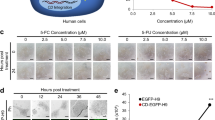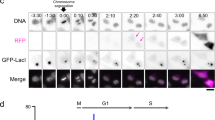Abstract
TRANSFORMATION is a well established process for the transfer of genetic information in bacteria1,2. Although such a system in higher organisms remains to be fully elucidated, certain features of gene transfer in eukaryotes have similarities with bacterial transformation3. The occurrence of inositol-independent (inl+) transformants has been reported in Neurospora when an inositol requiring (inl−) mutant strain (89601) is treated with a wild-type (RL3-8A) DNA preparation4,5. Although these transformants are stable for inositol independence (inl+) during the somatic cell cycle they differ in the ability to transmit this character to their sexual progeny. Essentially there are two groups of transformants, one capable of Mendelian transmission and another showing only a rare non-Mendelian transmission of the transformed character (inl+)5 (Table 1). Such differences in modes of genetic transmission can be explained if the donor DNA exists as an episome in the transformed strains. Thus the physical status of the episomes determines the Mendelian and non-Mendelian transmission of the genetic character controlled by them. When integrated they are transmitted in a Mendelian way like any other chromosomal gene; whereas in the non-integrated (autonomous) form their nucleolytic degradation (or slow replication followed by segregation) during meiosis can lead to non-Mendelian transmission. This hypothesis is supported by demonstration of a continued aberrant transmission of the inositol independence to the sexual progeny in the subsequent generations5. Here we describe experiments which establish further the validity of the above hypothesis.
This is a preview of subscription content, access via your institution
Access options
Subscribe to this journal
Receive 51 print issues and online access
$199.00 per year
only $3.90 per issue
Buy this article
- Purchase on Springer Link
- Instant access to full article PDF
Prices may be subject to local taxes which are calculated during checkout
Similar content being viewed by others
References
Avery, O. T., McLeod, C. M., and McCarthy, M., J. exp. Med., 79, 137–158, (1944).
Hotchkiss, R. D., in Informative Molecules in Biological Systems (edit. by Ledoux, L. G. H.), 1–4 (North-Holland, Amsterdam, 1971).
Ottolenghi-Nightingle, E., 1974 in Cell Communication (edit. by Cox, R. P.), 233–254 (Wiley, New York, 1974).
Mishra, N. C., Szabo, G., and Tatum, E. L., (1973), in The Role of Nucleic Acids in Reproduction and Development (edit. by Niu, M. C., and Segal, S. J.), 261–273 (North-Holland, Amsterdam, 1973).
Mishra, N. C., and Tatum, E. L., Proc. natn. Acad. Sci. U.S.A. 70, 3875–3879 (1973).
Clowes, R., Bact. Rev., 36, 361–405 (1972).
Hirata, Y., Proc. natn. Acad. Sci. U.S.A., 46, 57–64 (1960).
Bouanchang, D. H., Scavizzi, M. R., and Chabbert, Y. A., J. gen. Microbiol., 54, 417–425 (1969).
Tsai, C. C., Jain, S. C., and Sobell, H. M., (1975), Proc. natn. Acad. Sci. U.S.A., 72, 628–632 (1975).
Waring, M. J., Nature, 219, 1320–1325 (1968).
Lerman, L. S., J. molec. Biol., 3, 18–32 (1961).
Tatum, E. L., Barratt, R. W., and Cutter, V. M., Science, 109, 509–511 (1949).
Jacob, F., and Wollman, J. L., Sexuality and the Genetics of Bacteria (Academic, New York, 1961).
Brenner, S., Barnett, L., Crick, F. H. C., and Orgel, A., J. molec. Biol., 3, 121–124 (1961).
Sager, R., and Lane, D., Proc. natn. Acad. Sci. U.S.A., 69, 2410–2417 (1972).
Sager, R., and Kitchin, R., Science, 189, 426–432 (1975).
Hirata, Y., and Iijima, T., Nature, 180, 655–656 (1957).
Watanabe, T., and Fukasawa, T., J. Bact., 81, 697–683 (1961).
Tocchini-Valentini, G. P., and Crippa, M., On cogenic Viruses, Second Lepetit Colloquium (edit. by Silvestri, L.), 237–243 (North-Holland, Amsterdam, 1971).
Fox, A. S., Duggleby, W. F., Gelbart, W. M., and Yoon, S. B., Proc. natn. Acad. Sci. U.S.A., 67, 1834–1838 (1970).
Author information
Authors and Affiliations
Rights and permissions
About this article
Cite this article
MISHRA, N. Episome-like behaviour of donor DNA in transformed strains of Neurospora crassa. Nature 264, 251–253 (1976). https://doi.org/10.1038/264251a0
Received:
Accepted:
Issue Date:
DOI: https://doi.org/10.1038/264251a0
This article is cited by
-
RNase-sensitive DNA polymerase activity in cell fractions and mutants of Neurospora crassa
Biochemical Genetics (1980)
Comments
By submitting a comment you agree to abide by our Terms and Community Guidelines. If you find something abusive or that does not comply with our terms or guidelines please flag it as inappropriate.



